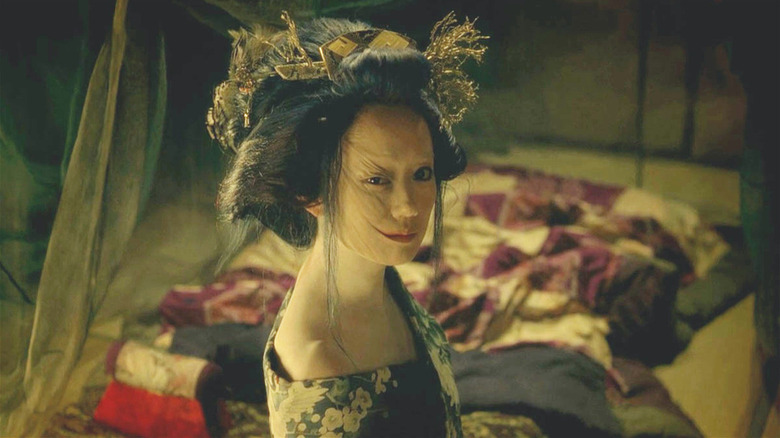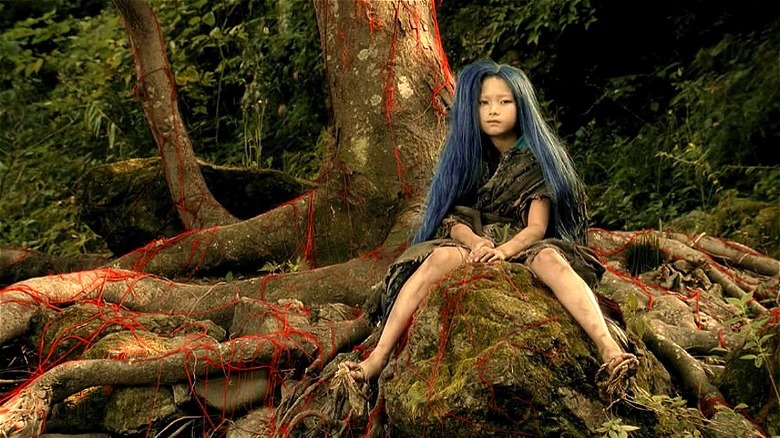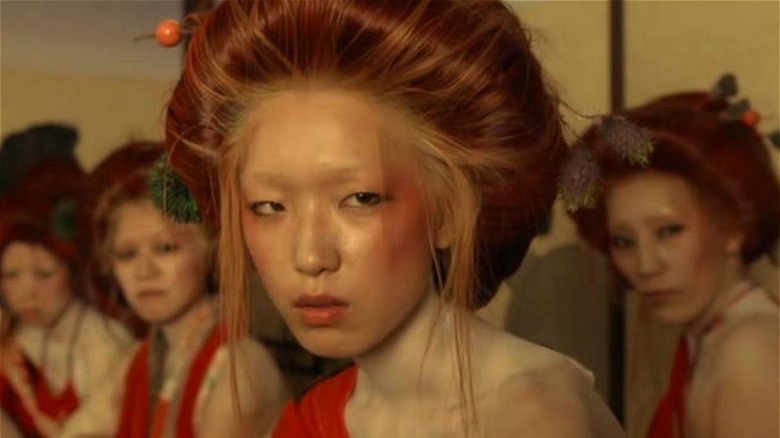When Takashi Miike Heard He Could Do 'Anything' For Masters Of Horror, He Put That To The Test
Takashi Miike's brand of horror can be described as visceral and deeply disturbing, often verging on lurid depictions of violence and gore. While the prolific Japanese director possesses the gift to tackle a wide range of genres, Miike's horror offerings stand out for their transgressive and (subjectively) taboo subject-matters. His horror series, "Connect," is yet another grisly story that features sadistic killers and perverse truths, but also lacks the telltale gore that characterizes Miike's horror oeuvre. While Miike's "Connect" plates up unsavory themes in a palatable manner, his contribution to the anthology series "Masters of Horror," which was scheduled to air on Showtime in 2006, was ultimately shelved after being considered too extreme for American viewers.
I'm talking about Miike's "Imprint," which follows an American journalist in search of his first love, whose fate might or might not have ended up being horrifying beyond comprehension. Now, Mick Garris put together "Masters of Horror" with the intention of creating an anthology of spine-chilling tales directed by masters in the genre, including John Carpenter, Dario Argento, Tope Hooper, and Stuart Gordon. Although every entry in Garris' 13-episode series has something truly unique to offer, Miike's "Imprint" — and this is no hyperbole — is truly the stuff of the most grotesque, scarring nightmares. Being the only episode to be canceled in the anthology, "Imprint" was later released on DVD for our viewing pleasure.
Was Miike aware that his story pushed the boundaries of what was deemed acceptable on American television at the time? Not really. During a 2019 interview with Bloody Disgusting, Miike talked about how "Imprint" is undoubtedly "the scariest project" he has worked on and explained how he was under the impression that he could do whatever he wanted. So he did what he does best: scare the bejeezus out of people.
Artistic freedom has no limits
Takashi Miike is no stranger to controversy. Most of his extreme cinema, which includes ultra-violent gangster films and horror tales that feature sexual perversity and over-the-top gore, have been the subject of extensive criticism and scrutiny. However, Miike does not simply indulge in the extreme for the sake of shock value. His stories disturbingly incorporate deep-seated human fears (many of which can be traced back to history and folklore) into everyday, pragmatic scenarios. Miike never holds back, as he infuses every film he makes with qualities that reflect his eccentric aesthetic and disruptive outlook.
As a result, when Miike was approached by Mick Garris and asked to contribute to "Masters of Horror" without any artistic limitations, the director naturally went all out. However, a boundless, unchecked Miike was too much for television network sensibilities. While Garris was receptive to a milder, edited version, Showtime deemed the episode completely un-airable. Miike shared his thoughts about the cancellation of the episode with BD:
"Everyone kept telling me that America's a free country and that I could really do whatever I wanted. It's cable TV, so don't hold back at all and make it as scary as possible. So I did that and then when I showed it to the producers in Japan, they were like, 'I know we told you that you can do anything, but this is going too far. This is way too far.'"
Although it's unfortunate "Imprint" could not make it onto cable TV along with the rest of "Masters of Horror," it is crucial to appreciate the mechanics of Miike's sordid tale. The unsettling and macabre nature of the story is sure to induce feelings of repulsion and unease, which, I would argue, is one of the many facets of effective horror storytelling.
Intertwining extreme horror and pathos
Takashi Miike structures "Imprint" like a kaidan or ghost story, with the plot being set in the 19th century and the final reveal incorporating the myth of the Futakuchi-onna, a malevolent spirit in Japanese lore. The tale opens with Christopher (Billy Drago) traveling to Japan in search of a former lover named Komono (Michie Itô), whom he had promised to return to decades ago. Miike tints his scenes with the macabre from the get-go, as there's a shot of a bloated female corpse at the beginning which foreshadows what's to come. Things get more intense as Christopher's search for Komono progresses, especially when he meets a disfigured woman (a brilliant Youki Kudoh) who recounts wildly different, increasingly disturbing accounts of Komono's fate.
Perhaps one of the reasons why Showtime did not move forward with "Imprint" is the horrific torture scene that cements the tone of Miike's tale about lost love. In this recounting of events, Komono is dangled upside down and graphically tortured, wherein her underarms are burnt and her gums are poked with nails. As if this wasn't disturbing enough, Miike introduces good old body horror into the mix, using the implications of Christopher's fate to deal the final blow to the audience's already-scarred mind. The transition from Christopher being presented as someone in control of his situation to him being a pitiful victim of a horrifying revelation is extremely effective and brings the final scene in the story full circle.
Miike's "Imprint" remains a brilliant, unforgettable saga about repressed guilt and the weight of unfulfilled promises, with a smattering of trauma-induced delusions of morality. The way in which Miike chooses to depict these themes is unbearably honest — perhaps a bit too honest for everyone's liking.


